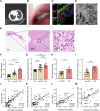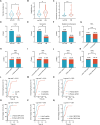Neutrophils are involved in the development and outcomes of plastic bronchitis associated with Mycoplasma pneumoniae pneumonia
- PMID: 40057734
- PMCID: PMC11890523
- DOI: 10.1186/s12931-025-03167-z
Neutrophils are involved in the development and outcomes of plastic bronchitis associated with Mycoplasma pneumoniae pneumonia
Abstract
Background: Previous research has demonstrated a notable increase in neutrophil counts among pediatric patients with plastic bronchitis (PB) associated with Mycoplasma pneumoniae pneumonia (MPP). However, the role of neutrophils in MPP-associated PB remains largely elusive.
Methods: This is a nested case-control study that enrolled patients diagnosed with MPP who underwent bronchoscopy in our department during the MPP pandemic from September 2023 to January 2024. We conducted an analysis of clinical characteristics, blood samples, bronchoalveolar lavage fluid (BALF), and cast specimens, correlating these factors with the development and outcomes of PB.
Results: Among the 557 patients with MPP included in the study, 21 (3.8%) developed PB. The peripheral neutrophil count was identified as an independent risk factor for PB (OR = 3.113 [95%CI 1.050-9.224], P = 0.04) and exhibited strong predictive value for the condition (AUC = 0.885 [95%CI 0.796-0.975], P < 0.001). Notably, there was a marked presence of neutrophil infiltration and neutrophil extracellular traps (NETs) formation in the blood, BALF, and cast samples from patients with PB. Furthermore, the levels of neutrophils and NETs correlated significantly with clinical outcomes.
Conclusion: A high level of neutrophils poses a risk for PB and demonstrates strong predictive value for its diagnosis. Neutrophils and NETs are closely linked to the clinical outcomes of PB in patients with MPP.
Keywords: Mycoplasma pneumoniae; Neutrophil extracellular traps; Neutrophils; Outcomes; Plastic bronchitis.
© 2025. The Author(s).
Conflict of interest statement
Declarations. Ethics approval: This study was approved by the research ethics committee of our institution (approval number: 202308005-1) and complied with the Declaration of Helsinki. Informed consent: The parents of all participating children provided written informed consent before inclusion in the study. Consent for consent for publication: Not applicable. Competing interests: The authors declare no competing interests.
Figures





Similar articles
-
Bronchoalveolar lavage cytokine profile and clinical features as risk predictors of plastic bronchitis in children with Mycoplasma pneumoniae pneumonia.Ital J Pediatr. 2025 Jun 7;51(1):175. doi: 10.1186/s13052-025-02041-4. Ital J Pediatr. 2025. PMID: 40483477 Free PMC article.
-
Distinct clinical characteristics of bocavirus and Mycoplasma pneumoniae infection in children plastic bronchitis.Immun Inflamm Dis. 2024 Aug;12(8):e1373. doi: 10.1002/iid3.1373. Immun Inflamm Dis. 2024. PMID: 39150240 Free PMC article.
-
Clinical features and risk factors of plastic bronchitis caused by Mycoplasma pneumoniae pneumonia in children.BMC Pulm Med. 2023 Nov 23;23(1):468. doi: 10.1186/s12890-023-02766-0. BMC Pulm Med. 2023. PMID: 37996853 Free PMC article.
-
Mycoplasma pneumoniae pneumonia-associated thromboembolism with plastic bronchitis: a series of five case reports and literature review.Ital J Pediatr. 2024 Jun 18;50(1):117. doi: 10.1186/s13052-024-01690-1. Ital J Pediatr. 2024. PMID: 38886770 Free PMC article. Review.
-
[Analysis of 3 cases with Mycoplasma pneumoniae-associated hemophagocytic syndrome and review of literature].Zhonghua Er Ke Za Zhi. 2014 Oct;52(10):792-6. Zhonghua Er Ke Za Zhi. 2014. PMID: 25537549 Review. Chinese.
References
-
- Meyer Sauteur PM, Beeton ML. Mycoplasma pneumoniae: delayed re-emergence after COVID-19 pandemic restrictions. Lancet Microbe 2023. - PubMed
-
- Meyer Sauteur PM, Beeton ML. Pneumonia outbreaks due to re-emergence of Mycoplasma pneumoniae. Lancet Microbe 2024. - PubMed
-
- Huang X, Gu H, Wu R, Chen L, Lv T, Jiang X, Li H, Guo B, Liu J, Li D, et al. Chest imaging classification in Mycoplasma pneumoniae pneumonia is associated with its clinical features and outcomes. Respir Med. 2024;221:107480. - PubMed
MeSH terms
Grants and funding
LinkOut - more resources
Full Text Sources
Medical
Miscellaneous

